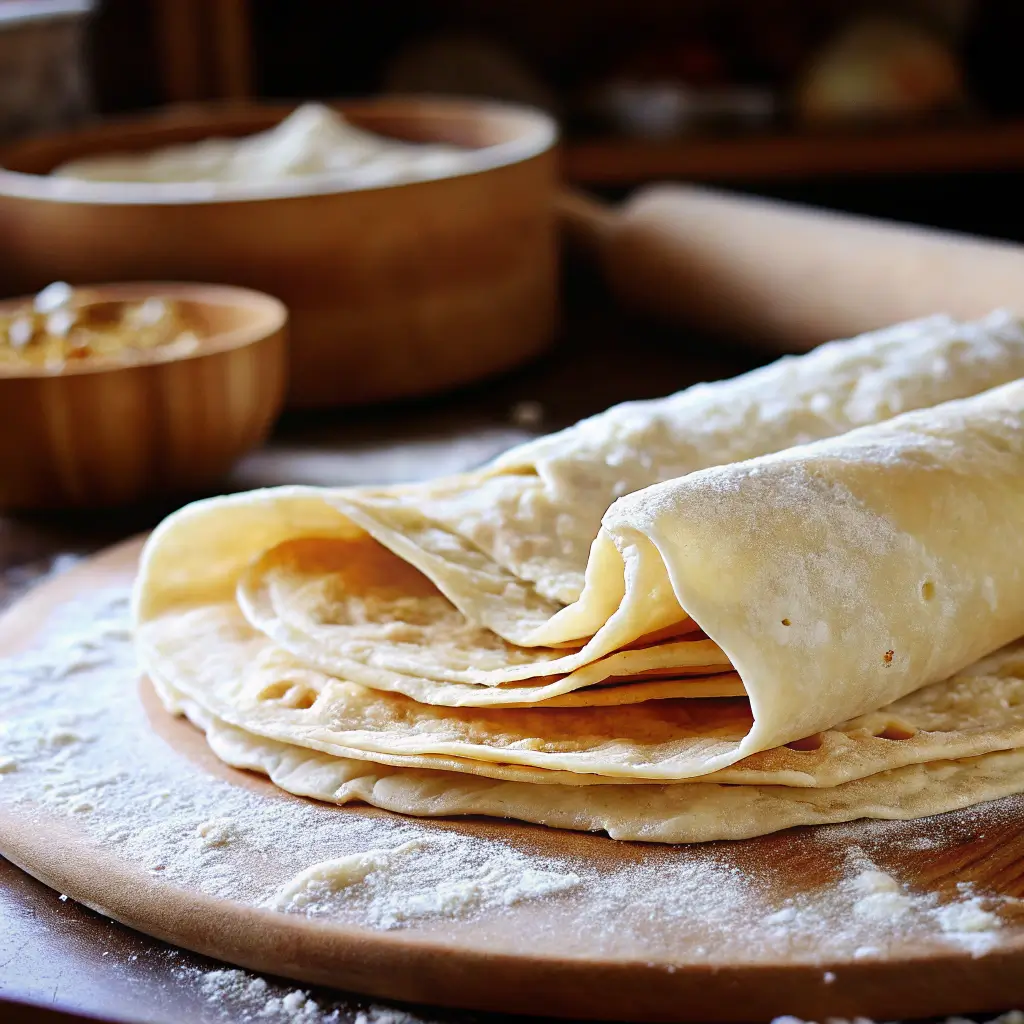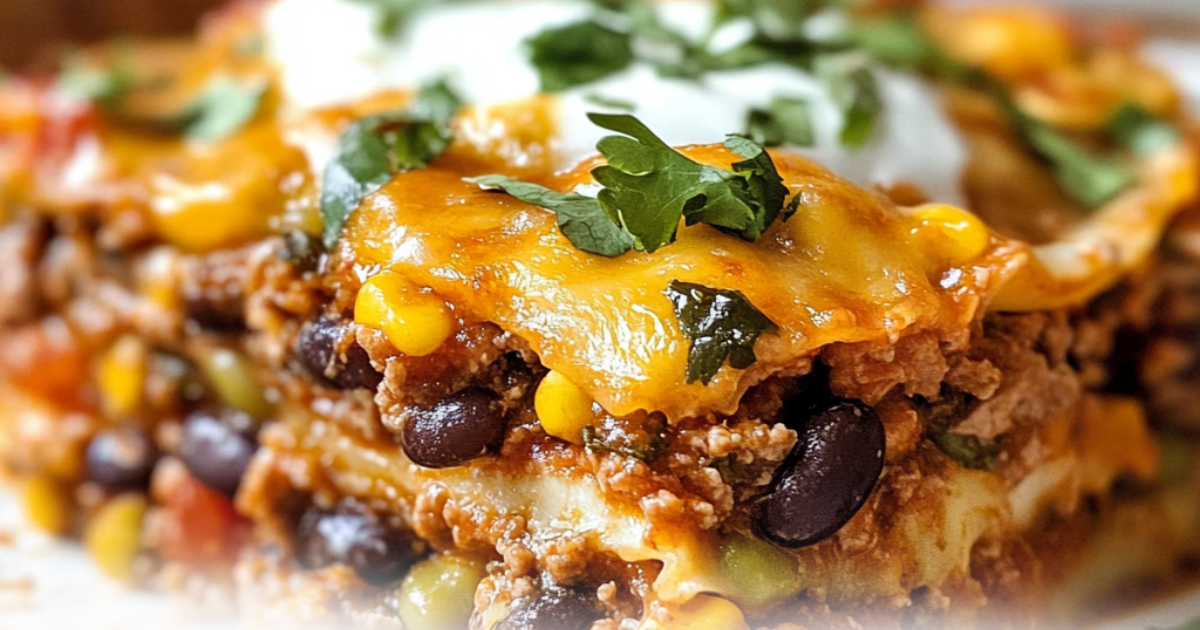Mexican lasagna is a mouthwatering fusion dish that combines the best of two culinary worlds: Mexican flavors and Italian-style layered casseroles. From its tortilla-based layers to its cheesy, savory fillings, it’s a dish that caters to a variety of tastes and dietary preferences. In this article, we’ll explore its origins, the ingredients that make it so unique, and the step-by-step process to create this flavorful dish. Let’s dive into the layers—both literal and figurative—of Mexican lasagna!
Table of contents
Introduction to Mexican Lasagna
What Makes Mexican Lasagna Unique?
Mexican lasagna is a creative spin on traditional lasagna, where tortillas often replace pasta sheets, giving the dish its distinct flavor and texture. It’s loaded with bold Mexican-inspired seasonings like cumin, chili powder, and paprika. While traditional lasagna leans heavily on marinara sauce, Mexican lasagna uses zesty alternatives such as enchilada or salsa verde.
This dish is incredibly versatile, making it perfect for family dinners, potlucks, or meal prep. The layers of tortillas, proteins, and cheese are not only delicious but also easy to customize based on dietary needs and preferences. Whether you’re a meat lover, vegetarian, or gluten-free, there’s a version of Mexican lasagna for everyone.

Traditional Ingredients of Mexican Lasagna
Base Layers: Tortillas or Pasta?
One of the defining features of Mexican lasagna is its base. Unlike traditional lasagna, which relies on pasta sheets, Mexican lasagna typically uses soft tortillas. These can be flour or corn tortillas, depending on personal preference and dietary needs. Corn tortillas bring an authentic, earthy flavor, while flour tortillas provide a softer, more cohesive texture. However, some creative cooks experiment with using pasta, making it a true blend of Italian and Mexican culinary traditions.

The layers of tortillas create a sturdy structure that absorbs the sauces and seasonings beautifully, adding to the rich taste of the dish. So, if you’ve ever wondered, what is Mexican lasagna made of?, the tortillas are a key component!
Protein Options: Beef, Chicken, or Vegetarian
When it comes to the filling, the options are almost endless. Ground beef is a classic choice, seasoned with bold spices like chili powder, cumin, garlic, and onion. Shredded chicken or even pulled pork works just as well, offering a tender and juicy alternative to beef.

For those who prefer vegetarian options, black beans, pinto beans, or lentils make an excellent base. These proteins pair wonderfully with roasted vegetables like zucchini, bell peppers, and corn. This adaptability is one of the reasons Mexican lasagna has gained such widespread popularity—it truly caters to everyone’s taste buds!
Classic Mexican Spices and Seasonings
The secret to the robust flavor of Mexican lasagna lies in the Mexican-inspired spices. Cumin, paprika, chili powder, and garlic powder create a savory, smoky blend that’s instantly recognizable. Fresh additions like cilantro, lime, and green onions elevate the flavor even further.
Enchilada sauce, salsa verde, or even a homemade tomato-based sauce infused with spices can tie everything together. These seasonings not only provide the dish with its signature taste but also ensure that each bite is packed with bold flavors.
Building Layers for Flavor
The Role of Sauces: Enchilada Sauce and Alternatives
Sauces are a vital ingredient when answering the question, what is Mexican lasagna made of? Enchilada sauce is the most commonly used, lending its tangy and spicy notes to the dish. Red enchilada sauce offers a deep, smoky flavor, while green enchilada sauce or salsa verde adds a fresh, zesty twist.
For those who like experimenting, a creamy chipotle sauce or even a queso-based sauce can be added for richness. These sauces seep into the tortillas and fillings, ensuring every layer is bursting with flavor.
Incorporating Vegetables for Texture and Nutrition
Vegetables play an important role in balancing the richness of the cheese and sauces. Common additions include diced tomatoes, sweet corn, sautéed onions, and bell peppers. Adding layers of spinach, zucchini, or even roasted sweet potatoes gives the dish a hearty, wholesome twist. Not only do these ingredients add texture, but they also enhance the nutritional profile of the dish.
For a crunchy finish, many cooks sprinkle diced green onions or fresh jalapeños on top after baking. The contrast between the soft layers and crispy toppings creates an irresistible texture.
Cheese Choices: From Cheddar to Queso Fresco
Cheese is the crowning glory of Mexican lasagna. Traditional options like cheddar, Monterey Jack, or mozzarella are commonly used for their melty goodness. For an authentic touch, queso fresco or cotija cheese can be crumbled on top for added flavor.
Some recipes even mix multiple cheeses to create a balance of creaminess and sharpness. Whatever cheese you choose, it ties the layers together and gives the dish its iconic golden-brown crust when baked.For advice on balancing flavors, check out What Is the Healthiest Cheese for Recipes?.
Variations of Mexican Lasagna
Gluten-Free and Dairy-Free Options
For those with dietary restrictions, Mexican lasagna can easily be adapted to fit gluten-free and dairy-free lifestyles. Corn tortillas are a naturally gluten-free alternative to flour tortillas, making them an excellent choice for this dish. Additionally, many stores offer gluten-free enchilada sauces to ensure the dish remains safe for everyone at the table.
For a dairy-free option, plant-based cheeses like almond or cashew-based varieties work wonders. You can also use nutritional yeast for a cheesy flavor without dairy. Even with these substitutions, the dish retains its classic, savory flavors.
Regional Twists Across Mexico
Though Mexican lasagna is more of a Tex-Mex creation, variations inspired by different regions in Mexico add unique twists to the dish. For example, Oaxacan versions might incorporate mole sauce for a smoky, rich flavor, while Yucatecan variations might feature shredded chicken seasoned with achiote.
Incorporating regional ingredients like roasted poblano peppers, chorizo, or even nopales (cactus) can transform the dish into a celebration of Mexico’s culinary diversity. Whether you stick to tradition or add a regional flair, there’s no limit to the creativity you can bring to the recipe.
International Takes on the Recipe
The appeal of Mexican lasagna has inspired international adaptations. Some variations include Asian-Mexican fusion, using wonton wrappers instead of tortillas, or Mediterranean-inspired versions with feta cheese and olives. These global interpretations highlight how this dish has become a beloved template for culinary experimentation.
If you’re looking for more Tex-Mex inspiration, check out the Lasagna Tacos Recipe on Zenarecipes for another creative twist on fusion cuisine!
Step-by-Step Guide to Making Mexican Lasagna

Preparing the Ingredients
The first step in making Mexican lasagna is to gather your ingredients. You’ll need tortillas (corn or flour), your choice of protein (ground beef, chicken, or beans), enchilada sauce, shredded cheese, and any additional vegetables like bell peppers or corn. Prepping these ingredients in advance makes the assembly process much smoother.
Make sure to cook the protein and vegetables ahead of time. Season them generously with classic Mexican spices such as cumin, paprika, and chili powder for bold flavor.
Layering Techniques for Perfect Consistency
Start by spreading a thin layer of enchilada sauce at the bottom of your baking dish to prevent sticking. Then, layer tortillas, followed by the protein, sauce, vegetables, and cheese. Repeat the layers until the dish is full, ending with a final topping of cheese for that golden, bubbly crust.
Pro tip: Cut the tortillas to fit snugly in your baking dish to ensure an even structure. This attention to detail keeps your layers intact when serving.
Tips for Baking and Serving
Bake the lasagna at 375°F (190°C) for about 25–30 minutes, or until the cheese is bubbly and golden. Let it cool for 10 minutes before slicing to prevent the layers from falling apart. Garnish with fresh cilantro, diced jalapeños, or a dollop of sour cream for added flair.
For leftovers, Mexican lasagna stores beautifully. It can be refrigerated for up to three days or frozen for meal prep, making it a practical option for busy weeks.
By exploring these sections, we’ve answered what is Mexican lasagna made of? while also diving into its exciting variations and preparation techniques. Now, you’re all set to create this delicious dish in your own kitchen!
FAQs About Mexican Lasagna
Can Mexican Lasagna Be Made Ahead?
Yes, it’s perfect for meal prep! Assemble it a day or two in advance, refrigerate, and bake when needed. You can also freeze it for up to three months. Thaw overnight and bake for a hassle-free meal.
How Long Does Mexican Lasagna Last in the Fridge?
Mexican lasagna stays fresh in the fridge for 3–4 days. Store it in an airtight container and reheat in the microwave or oven for best results.
What Are Popular Side Dishes to Serve With It?
Pair it with a fresh salad, Mexican rice, or refried beans. Guacamole, salsa, or grilled vegetables also work wonderfully for a complete meal.

